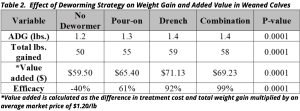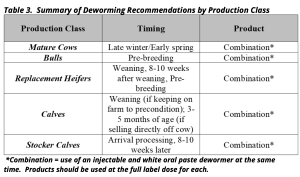Source: Brent Credille, D.V.M., Ph.D., Food Animal Health and Management Program, University of Georgia
Internal parasites represent a source of significant economic loss in almost all segments of beef production. The implementation of an internal parasite control program can lead to increased weaning weights in calves and increased pregnancy rates in heifers and cows. One study that was performed in Watkinsville, GA found that a single dose of Panacur given at the label dose to cows in early May resulted in a 22% increase in both pregnancy and calving rate compared to cattle that were not dewormed.Similar, but more recent, work from Louisiana has found that cows dewormed with Panacur midsummer had a 12% increase in pregnancy rate compared to untreated cows. To put this in economic context with current market prices, deworming cows represents a nearly 4,000% return on investment due to the increased number of calves available for marketing. In addition, that same study showed that calves dewormed at 3-5 months of age gained 0.3 lb./day more than calves that were not dewormed and weighed, on average, 25-45 lbs. more at weaning than control calves. Again, to put this into economic context using current market prices, the use of dewormers in calves represents a 1,500 – 3,000% return on investment due to heavier weaning weights. An analysis from Iowa State University performed in 2007 found that if dewormers were removed from use in the cowherd altogether, the breakeven price for that operation would increase by 34% and the cost per cow would increase by $165/head. That same study showed that removing dewormers from use in weaned feeder calves increased breakeven price by 3% and increased cost per calf by $21.A summary of the economic impact of dewormers can be found below in Table 1.

DEWORMER RESISTANCE: AN EMERGING ISSUE
Over the last 30 years, control of parasites on cattle operations has relied almost exclusively on the use of dewormers. Unfortunately, dewormer resistance is becoming more common and resistance is particularly prevalent in Southeastern cattle herds. A recent study from the USDA found that approximately 50% of herds surveyed had resistance to brand name pour-on dewormers and over 75% had resistance to generic pour-on dewormers.That same study showed that only 20% of herds had resistance to brand name injectables and no herds had resistance to oral white paste dewormers. Recent work evaluating dewormer resistance in weaned calves on farms in Georgia performed by the parasitology group at the University of Georgia found that resistance to commonly used dewormers was found on 92% of farms surveyed. This same study also found complete dewormer failure on one of the farms involved in the study. A similar study just performed in weaned calves at 4 University of Georgia Experiment Stations found that calves dewormed with either an oral white paste or an oral white paste combined with an injectable dewormer gained 10 lbs. more than animals that were not dewormed, and 5 lbs. more than animals dewormed with just an injectable dewormer alone over the course of a 42-day growing period.This equates to an additional 0.15 lbs./day in ADG and translates to a $10-12 per calf increase in profit, even with the cost of dewormer included (Table 2).

PRINCIPLES OF DEWORMER USE
Mature cows
Mature cows are generally less susceptible to the effects of parasites than other groups of animals due to the fact that they develop an immunity over the course of multiple grazing seasons. However, some breeds of cattle, particularly cattle with heavy Brahman influence, remain susceptible into their late adult years. An ideal approach to deworming adult cows is to deworm them in late winter or early spring with a combination of an injectable dewormer and oral white paste. Deworming them at this time of year is important because they have come through the winter and are under nutritional stress. In addition, parasite burdens are highest during the cooler months of the year and more benefit is gained from the use of dewormers now relative to using them in late spring or early summer. Furthermore, a lot of herds calve in late winter and early spring. Calving creates issues with immune function that allow parasites to take a hold in animals more easily. At the end of the day, making this transition will help improve cow performance. In addition, deworming cattle at this time has the potential to enhance calf weaning weight through an increase in milk production. This is different from the previous recommendations of deworming all animals in late spring or early summer. We realize, today, that this recommendation is inappropriate due to the fact that parasite burdens are lowest during this time of year and this practice increases resistance in parasite populations.
Bulls
Bulls are generally considered more susceptible to the effects of parasites than other classes of animals. Bulls should be dewormed with both an injectable dewormer and oral white paste prior to the beginning of the breeding season.
Replacement heifers
Due to their age and lack of immunity, replacement heifers are particularly susceptible to the effects of parasites. Research has found that replacement heifers dewormed appropriately gave birth to 15% more calves than heifers not dewormed. In addition, these same heifers weaned calves that weighed 10% more at weaning. Clearly, deworming replacement heifers is a wise investment for a cow-calf operation.Replacement heifers should be dewormed at weaning and then again prior to breeding. Due to the long period of time between weaning and breeding, an additional deworming may be included between these two time points depending on heifer condition, environmental conditions, and climate. Like cows and bulls, heifers should be dewormed with both an injectable dewormer and oral white paste.
Calves
For herds that maintain calves on farm in a precondition phase after weaning, dewormers can be given at weaning. For herds that sell calves off the cow at weaning, dewormers should be administered at 3-5 months of age. This will allow for the capture of an additional 0.3 lbs./day of growth and 30-40 lbs. of additional weight at the time of sale. As with other production classes, calves should be dewormed with both an injectable dewormer and oral white paste.
Stocker cattle
Stocker cattle are particularly susceptible to the effects of parasites due to the effects of stress and poor nutritional status. Not only will parasites affect performance but parasites also increase the risk of bovine respiratory disease (BRD). In fact, work from researchers at UGA and Mississippi State found that for every 100 egg per gram increase in fecal egg count the risk of BRD increased by 30%. Stocker cattle should be dewormed at the time of arrival processing and then again 8-10 weeks later with both an injectable dewormer and oral white paste.Work form our lab has shown this combination to be >98% effective in this class of animals. A summary of deworming recommendations for the different production classes can be found below in table 3.











